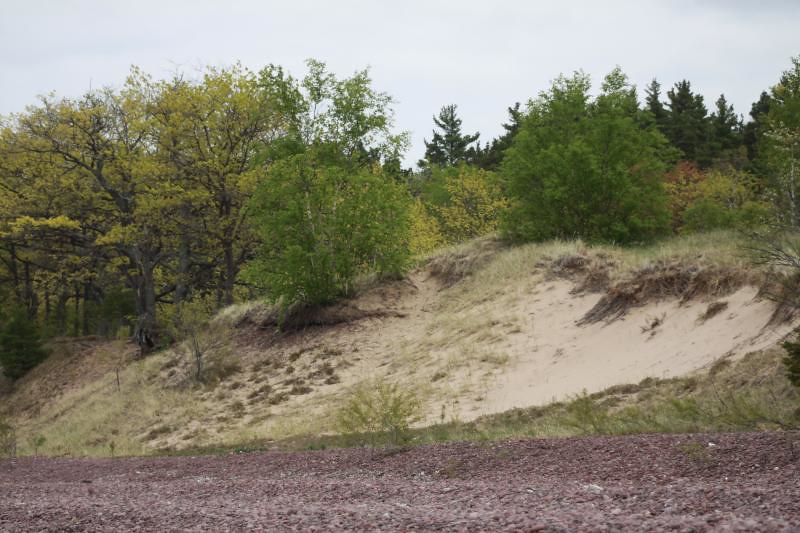In 2010 Mike Link and Kate Crowley chose to walk around the largest fresh water lake in the world – Lake Superior which has shoreline in both Canada and the United States. This 1555 mile/145 day walk was the first ever by a couple and the first to attempt to stay on the shoreline. Because Mike and Kate are educators in their sixties they wanted to deliver important information about the lake to inspire others to care for it. As a researcher and college professor Mike wanted the adventure to have information for his courses and for research institutions around the lake. This is Part III in the Full Circle Superior series. For more information, read Part I and Part II.
Traveling around the lake was easier for us in 2010 than it might have been in other years. We faced a minimum of bad weather days, the insects were never maddening, and we had the knowledge that if we could get to the shore we could legally walk to the “normal high water” line and not be trespassing. This becomes more difficult when the normal high water line is half way up a cliff, but for most of Wisconsin, Michigan and up to Montreal Harbor in Canada, this fact made life much easier for us.

Dunes at Keweenaw
The reason that we could walk to the normal high water line was also the bane of many of the Canadian land owners: Lake Superior water level was down. Now, their docks were so far from the water that you could walk to the end of some docks and jump onto bare, dry rock. This was especially apparent to us on the Goulais Peninsula where there were break waters, docks, boat launches, and boat houses many meters from the water’s edge. As a result of this condition, and the fact that this has been a multi-year issue, the shoreline is being altered in ways that were not allowed in the past. The Ontario Ministry of Natural Resources has allowed some cabin owners to create channels to get their boats in and out.
In 2007, Seagrant published a newsletter that put a lot of perspective on the lake levels
“Since 1998, Lake Superior has slipped to the shallower side of average. This year the lake could sink to a new low. Experts point to two main reasons for this:
• Less precipitation
• More evaporationEach year, about 2.5 feet (77 cm) of water hits Lake Superior directly as rain or snow. Two more feet flow in through streams and ground water, which reflect precipitation that falls on land within the watershed. This year (2010), precipitation has been short by about 6 inches (15 cm) across the Lake Superior Basin.
Less water in, more water out: Last winter’s sparse ice cover allowed more water to evaporate. Contrary to what one might guess, Lake Superior evaporates fastest from October to February when dry cold air from Canada moves over the warmer surface of the lake soaking up water like a sponge. The ice works like a lid on the big Superior jar and when it is left open the liquid meets the air and the air moves it out of the basin. When the lake looks like it is boiling in the winter, it is actually the water changing to vapor. This is normal up to a point.
For at least the last 150 years, Lake Superior has lost and gained massive amounts of water (on the order of 20 cubic miles) while maintaining a remarkably even water level, varying only about four feet (1.2 m).”
Since 2007 the conditions have not changed appreciably – the Army Corp of engineers in 2011 said the lake was 9 inches below 2010 levels. The ice cover on the lake in the winter has fallen far beneath the normal averages leading to more evaporation. This has had an impact on the south shore where “lake effect” snows are counted on for their winter economy. As the Sea Grant article shows, there is not much water moving into the lake. It has a small watershed for its size.
Globe media in Canada caught the significance of the 2007 low water point when it published an article by John Flesher who wrote, “Preliminary data show Superior’s average water level in September dipped four centimeters beneath the previous low for that month reached in 1926.”
Cynthia Sellinger, deputy director of NOAA’s Great Lakes Environmental Research Laboratory, said, “It is the first time in 81 years that the biggest and deepest of the lakes has reached a new monthly low.”
Along the way we found people who would say, ‘the lake always fluctuates, it will come back,’ but in fact, Flesher notes that the “lake has plummeted over the past year and has dipped beneath its long-term average level for a decade – the longest such period in its known history.”
We were not in a position to measure the lake, but we were in a position to observe what the lake looked like and in some places this was quite disturbing. In the next part in this series, we will discuss the effects on different industries due to a changing Lake Superior.
